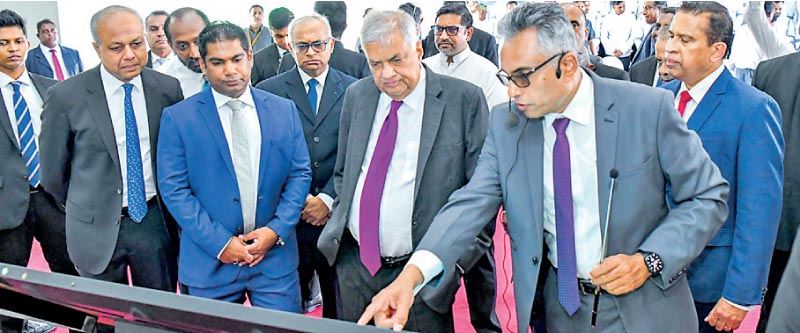Thursday Apr 24, 2025
Thursday Apr 24, 2025
Thursday, 29 August 2024 02:08 - - {{hitsCtrl.values.hits}}

In a significant move towards boosting Sri Lanka’s energy infrastructure, President Ranil Wickremesinghe yesterday inaugurated the first phase of the Sobadhanavi Combined Cycle Power Plant at Kerawalapitiya.
Designed by Lakdhanavi Ltd., this project marks a pivotal step in expanding the country’s electricity supply, a vital component for supporting long-term economic growth. The first phase of the Sobadhanavi Power Plant, now operational, features an F-class gas turbine with a capacity of 220 megawatts (MW). This addition to the national grid is expected to improve the reliability of electricity supply across the country.
The project’s second phase, anticipated to be completed by early 2025, will include the installation of a steam turbine. This turbine will utilise the heat generated by the gas turbine, increasing the plant’s total output to 350 MW and enhancing overall efficiency.
Speaking at the event, President Wickremesinghe emphasised the critical role of the Sobadhanavi power plant in providing a stable and affordable energy supply. The plant is expected to meet approximately 12% of Sri Lanka’s current electricity demand, directly benefiting thousands of workers and indirectly impacting millions of citizens.
Wickremesinghe underscored the importance of focusing on technology, the green economy and the digital economy to usher in a new era of growth for Sri Lanka.
“We are now beginning a new phase of economic development. No development can occur without power, without energy, and that is what we are focusing on,” he stressed.
The President highlighted that the plant’s completion would support industrial growth, job creation, and overall economic stability, underscoring the essential link between energy security and economic development.
Wickremesinghe reiterated Sri Lanka’s commitment to renewable energy as a cornerstone of its future energy strategy. He pointed out that while Sri Lanka had benefited significantly from hydropower projects initiated by past leaders, the country’s reliance on hydropower is nearing its end. The President stressed the importance of transitioning to new energy sources that align with global climate change policies.
“Sobadhanavi is a crucial power station for Sri Lanka, generating 350 megawatts,” said President Wickremesinghe.
He outlined plans for Sri Lanka to become a surplus producer of renewable energy, with aspirations to integrate into regional power networks such as the proposed India-Singapore power line.
“Renewable energy is essential to meeting the 2050 climate change deadline,” he added.
The President also identified green hydrogen as the next frontier, positioning Sri Lanka to leverage this emerging technology for both domestic energy needs and potential export.
Wickremesinghe emphasised the need for technological advancement across various sectors, including the power sector.
He announced plans to establish four technological universities in Sri Lanka to address the brain drain and equip the nation with skilled engineers and professionals. These universities will focus on technology, artificial intelligence, and other critical areas, ensuring that Sri Lanka is prepared for the future.
“The first technology university will be in Kurunegala, with others in Sithawaka or Kithulwala, and Siyane Korale,” the President noted. Additionally, he mentioned collaboration with Prime Minister Narendra Modi to establish a campus of the Chennai IIT in Sri Lanka, which is expected to evolve into a full-fledged university.
The President lauded LTL Holdings for its contributions to Sri Lanka’s energy sector, highlighting the company’s role in establishing numerous power plants across the country.
He praised LTL’s commitment to innovation and excellence, expressing confidence in the company’s ability to drive further developments both domestically and internationally.
“LTL has established so many power plants in the country that it is difficult to keep track,” the President remarked. “However, I am pleased to see LTL reach this stage. You have delivered, and you have succeeded—congratulations.”
He expressed his optimism for the country’s future, emphasising that these efforts would not only secure energy independence but also position Sri Lanka as a leader in sustainable development and technological innovation.
The inauguration was attended by Deputy High Commissioner of India to Sri Lanka Dr. Satyanjal Pandey, Power and Energy Minister Kanchana Wijesekera, Power and Energy Ministry Secretary Dr. Sulaksha Jayawardena, Ceylon Electricity Board Chairman Nalinda Ilangakoon as well as the Chairpersons and Board Members of Lakdhanavi, Sobadhanavi and LTL, along with engineers, staff from the power plant, and other distinguished guests.
Discover Kapruka, the leading online shopping platform in Sri Lanka, where you can conveniently send Gifts and Flowers to your loved ones for any event including Valentine ’s Day. Explore a wide range of popular Shopping Categories on Kapruka, including Toys, Groceries, Electronics, Birthday Cakes, Fruits, Chocolates, Flower Bouquets, Clothing, Watches, Lingerie, Gift Sets and Jewellery. Also if you’re interested in selling with Kapruka, Partner Central by Kapruka is the best solution to start with. Moreover, through Kapruka Global Shop, you can also enjoy the convenience of purchasing products from renowned platforms like Amazon and eBay and have them delivered to Sri Lanka.
Discover Kapruka, the leading online shopping platform in Sri Lanka, where you can conveniently send Gifts and Flowers to your loved ones for any event including Valentine ’s Day. Explore a wide range of popular Shopping Categories on Kapruka, including Toys, Groceries, Electronics, Birthday Cakes, Fruits, Chocolates, Flower Bouquets, Clothing, Watches, Lingerie, Gift Sets and Jewellery. Also if you’re interested in selling with Kapruka, Partner Central by Kapruka is the best solution to start with. Moreover, through Kapruka Global Shop, you can also enjoy the convenience of purchasing products from renowned platforms like Amazon and eBay and have them delivered to Sri Lanka.